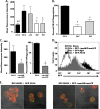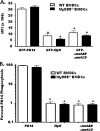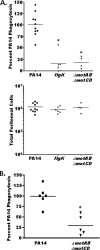Pseudomonas aeruginosa evasion of phagocytosis is mediated by loss of swimming motility and is independent of flagellum expression
- PMID: 20457788
- PMCID: PMC2897393
- DOI: 10.1128/IAI.00144-10
Pseudomonas aeruginosa evasion of phagocytosis is mediated by loss of swimming motility and is independent of flagellum expression
Abstract
Pseudomonas aeruginosa is a pathogenic Gram-negative bacterium that causes severe opportunistic infections in immunocompromised individuals; in particular, severity of infection with P. aeruginosa positively correlates with poor prognosis in cystic fibrosis (CF) patients. Establishment of chronic infection by this pathogen is associated with downregulation of flagellar expression and of other genes that regulate P. aeruginosa motility. The current paradigm is that loss of flagellar expression enables immune evasion by the bacteria due to loss of engagement by phagocytic receptors that recognize flagellar components and loss of immune activation through flagellin-mediated Toll-like receptor (TLR) signaling. In this work, we employ bacterial and mammalian genetic approaches to demonstrate that loss of motility, not the loss of the flagellum per se, is the critical factor in the development of resistance to phagocytosis by P. aeruginosa. We demonstrate that isogenic P. aeruginosa mutants deficient in flagellar function, but retaining an intact flagellum, are highly resistant to phagocytosis by both murine and human phagocytic cells at levels comparable to those of flagellum-deficient mutants. Furthermore, we show that loss of MyD88 signaling in murine phagocytes does not recapitulate the phagocytic deficit observed for either flagellum-deficient or motility-deficient P. aeruginosa mutants. Our data demonstrate that loss of bacterial motility confers a dramatic resistance to phagocytosis that is independent of both flagellar expression and TLR signaling. These findings provide an explanation for the well-documented observation of nonmotility in clinical P. aeruginosa isolates and for how this phenotype confers upon the bacteria an advantage in the context of immune evasion.
Figures






Similar articles
-
Step-wise loss of bacterial flagellar torsion confers progressive phagocytic evasion.PLoS Pathog. 2011 Sep;7(9):e1002253. doi: 10.1371/journal.ppat.1002253. Epub 2011 Sep 15. PLoS Pathog. 2011. PMID: 21949654 Free PMC article.
-
Flagellum-deficient Pseudomonas aeruginosa is more virulent than non-motile but flagellated mutants in a cystic fibrosis mouse model.Microbiol Spectr. 2024 Oct 3;12(10):e0132524. doi: 10.1128/spectrum.01325-24. Epub 2024 Sep 9. Microbiol Spectr. 2024. PMID: 39248473 Free PMC article.
-
Pseudomonas aeruginosa flagellar motility activates the phagocyte PI3K/Akt pathway to induce phagocytic engulfment.Am J Physiol Lung Cell Mol Physiol. 2014 Apr 1;306(7):L698-707. doi: 10.1152/ajplung.00319.2013. Epub 2014 Jan 31. Am J Physiol Lung Cell Mol Physiol. 2014. PMID: 24487390 Free PMC article.
-
Mechanisms of phagocytosis and host clearance of Pseudomonas aeruginosa.Am J Physiol Lung Cell Mol Physiol. 2014 Apr 1;306(7):L591-603. doi: 10.1152/ajplung.00335.2013. Epub 2014 Jan 24. Am J Physiol Lung Cell Mol Physiol. 2014. PMID: 24464809 Free PMC article. Review.
-
Modulation of macrophage function for defence of the lung against Pseudomonas aeruginosa.Behring Inst Mitt. 1997 Feb;(98):274-82. Behring Inst Mitt. 1997. PMID: 9382751 Review.
Cited by
-
Enhanced Clearance of Pseudomonas aeruginosa by Peroxisome Proliferator-Activated Receptor Gamma.Infect Immun. 2016 Jun 23;84(7):1975-1985. doi: 10.1128/IAI.00164-16. Print 2016 Jul. Infect Immun. 2016. PMID: 27091928 Free PMC article.
-
Assessment of the Glycan-Binding Profile of Pseudomonas aeruginosa PAO1.Microbiol Spectr. 2023 Aug 17;11(4):e0166723. doi: 10.1128/spectrum.01667-23. Epub 2023 Jul 20. Microbiol Spectr. 2023. PMID: 37470715 Free PMC article.
-
Detection of synergistic antimicrobial resistance mechanisms in clinical isolates of Pseudomonas aeruginosa from post-operative wound infections.Appl Microbiol Biotechnol. 2021 Dec;105(24):9321-9332. doi: 10.1007/s00253-021-11680-6. Epub 2021 Nov 19. Appl Microbiol Biotechnol. 2021. PMID: 34797390
-
Genetic and environmental determinants of surface adaptations in Pseudomonas aeruginosa.Microbiology (Reading). 2023 Jun;169(6):001335. doi: 10.1099/mic.0.001335. Microbiology (Reading). 2023. PMID: 37276014 Free PMC article.
-
Swimming Motility Mediates the Formation of Neutrophil Extracellular Traps Induced by Flagellated Pseudomonas aeruginosa.PLoS Pathog. 2016 Nov 17;12(11):e1005987. doi: 10.1371/journal.ppat.1005987. eCollection 2016 Nov. PLoS Pathog. 2016. PMID: 27855208 Free PMC article.
References
-
- Adachi, O., T. Kawai, K. Takeda, M. Matsumoto, H. Tsutsui, M. Sakagami, K. Nakanishi, and S. Akira. 1998. Targeted disruption of the MyD88 gene results in loss of IL-1- and IL-18-mediated function. Immunity 9:143-150. - PubMed
-
- Balloy, V., A. Verma, S. Kuravi, M. Si-Tahar, M. Chignard, and R. Ramphal. 2007. The role of flagellin versus motility in acute lung disease caused by Pseudomonas aeruginosa. J. Infect. Dis. 196:289-296. - PubMed
Publication types
MeSH terms
Substances
Grants and funding
LinkOut - more resources
Full Text Sources
Other Literature Sources
Molecular Biology Databases

